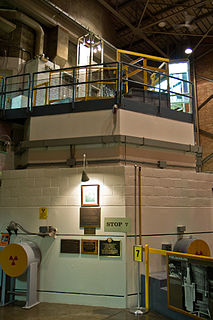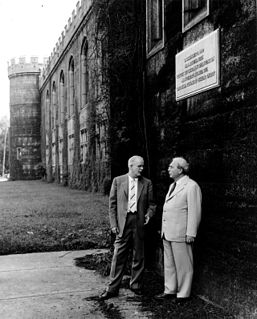The National Institute of Standards and Technology (NIST) is a physical sciences laboratory, and a non-regulatory agency of the United States Department of Commerce. Its mission is to promote innovation and industrial competitiveness. NIST's activities are organized into laboratory programs that include nanoscale science and technology, engineering, information technology, neutron research, material measurement, and physical measurement.

Los Alamos National Laboratory is a United States Department of Energy national laboratory initially organized during World War II for the design of nuclear weapons as part of the Manhattan Project. It is located a short distance northwest of Santa Fe, New Mexico in the southwestern United States.

Oak Ridge National Laboratory (ORNL) is an American multiprogram science and technology national laboratory sponsored by the U.S. Department of Energy (DOE) and administered, managed, and operated by UT–Battelle as a federally funded research and development center (FFRDC) under a contract with the DOE. ORNL is the largest science and energy national laboratory in the Department of Energy system by size and by annual budget. ORNL is located in Oak Ridge, Tennessee, near Knoxville. ORNL's scientific programs focus on materials, neutron science, energy, high-performance computing, systems biology and national security.

The United States Department of Energy (DOE) is a cabinet-level department of the United States Government concerned with the United States' policies regarding energy and safety in handling nuclear material. Its responsibilities include the nation's nuclear weapons program, nuclear reactor production for the United States Navy, energy conservation, energy-related research, radioactive waste disposal, and domestic energy production. It also directs research in genomics; the Human Genome Project originated in a DOE initiative. DOE sponsors more research in the physical sciences than any other U.S. federal agency, the majority of which is conducted through its system of National Laboratories. The agency is administered by the United States Secretary of Energy, and its headquarters are located in Southwest Washington, D.C., on Independence Avenue in the James V. Forrestal Building, named for James Forrestal, as well as in Germantown, Maryland.

Argonne National Laboratory is a science and engineering research national laboratory operated by the University of Chicago Argonne LLC for the United States Department of Energy located in Lemont, Illinois, outside Chicago. It is the largest national laboratory by size and scope in the Midwest.

Experimental Breeder Reactor I (EBR-I) is a decommissioned research reactor and U.S. National Historic Landmark located in the desert about 18 miles (29 km) southeast of Arco, Idaho. It was the world's first breeder reactor. At 1:50 p.m. on December 20, 1951, it became one of the world's first electricity-generating nuclear power plants when it produced sufficient electricity to illuminate four 200-watt light bulbs. Electricity had earlier been generated by a nuclear reactor on September 3, 1948 at the X-10 Graphite Reactor in Oak Ridge, Tennessee. EBR-I subsequently generated sufficient electricity to power its building, and continued to be used for experimental purposes until it was decommissioned in 1964. The museum is open for visitors from late May until early September.

The United States Department of Energy National Laboratories and Technology Centers are a system of facilities and laboratories overseen by the United States Department of Energy (DOE) for the purpose of advancing science and technology to fulfill the DOE mission. Sixteen of the seventeen DOE national laboratories are federally funded research and development centers administered, managed, operated and staffed by private-sector organizations under management and operating (M&O) contract with DOE.

Idaho National Laboratory (INL) is one of the national laboratories of the United States Department of Energy and is managed by the Battelle Energy Alliance. While the laboratory does other research, historically it has been involved with nuclear research. Much of current knowledge about how nuclear reactors behave and misbehave was discovered at what is now Idaho National Laboratory. John Grossenbacher, former INL director, said, "The history of nuclear energy for peaceful application has principally been written in Idaho".

The Environmental Measurements Laboratory (EML) is the former name of the current National Urban Security Technology Laboratory (NUSTL), a United States government-owned, government-operated laboratory. NUSTL is part of the Science and Technology (S&T) Directorate of the Department of Homeland Security (DHS). Effective December 1, 2009, EML was re-designated as NUSTL to reflect the Lab’s evolved mission and functions. NUSTL is the third name in the laboratory's history, following the Health and Safety Laboratory and the Environmental Measurements Laboratory (1977–2009).
Nuclear data represents measured probabilities of various physical interactions involving the nuclei of atoms. It is used to understand the nature of such interactions by providing the fundamental input to many models and simulations, such as fission and fusion reactor calculations, shielding and radiation protection calculations, criticality safety, nuclear weapons, nuclear physics research, medical radiotherapy, radioisotope therapy and diagnostics, particle accelerator design and operations, geological and environmental work, radioactive waste disposal calculations, and space travel calculations

The Site A/Plot M Disposal Site is located within Red Gate Woods and situated on the former grounds of Argonne National Laboratory and its predecessor, the University of Chicago Metallurgical Laboratory in Cook County, Illinois and is now part of the Palos Forest Preserve. The site contains buried radioactive waste from contaminated building debris, and the Chicago Pile-1 (CP-1/CP-2), and Chicago Pile-3 (CP-3) nuclear reactors.

The Illinois Technology and Research Corridor is a region of commerce and industry located along Interstate 88 in the Chicago metropolitan area, primarily in DuPage, Kane, and DeKalb Counties. The corridor is home to the headquarters or regional centers for many Fortune 1000 companies, several office and industrial parks, colleges and universities, research and scientific institutions, medical centers, government centers, and abundant shopping, dining, lodging, and entertainment amenities. In addition to the I-90 Golden Corridor, the I-94 Lakeshore Corridor, and the I-55 Industrial Corridor, the Illinois Technology and Research Corridor is one of the principal economic centers in suburban Chicago.
Red Gate Woods is part of a forest preserve within the Palos Division of the Forest Preserve District of Cook County, Illinois. Located within the preserve is the original site of Argonne National Laboratory and the Site A/Plot M Disposal Site, which contains the buried remains of Chicago Pile-1, the world's first nuclear reactor. After the initial tests, the reactor at Stagg Field at the University of Chicago was removed and reassembled at the Metallurgical Laboratory site in Red Gate Woods. Local residents reported encountering US Army MPs guarding the area during World War II but no one was aware of the true nature of the activities until long after the war. After further experiments and the shutdown of Pile 1, by then designated Pile 2, a huge hole was dug and the 2-story high reactor was pushed into it and buried. Other reactors were also built at the site and nuclear waste was buried there. The site is monitored by the United States Department of Energy and is open to the public.
The Office of Energy Efficiency and Renewable Energy (EERE) is an office within the United States Department of Energy. Formed from other energy agencies after the 1973 energy crisis, EERE's mission is to help support the development of clean, renewable and efficiency energy technologies to America and support a global clean energy economy. The Office of EERE is led by the Assistant Secretary of Energy Efficiency and Renewable Energy, who oversees three technology sectors: renewable energy, sustainable transportation, and energy efficiency. Within these sectors are 11 major technology offices and programs that support research, development, and outreach efforts.
The National Calibration Reference Centre for Bioassay and In Vivo Monitoring (NCRC) is administered by the Radiation Protection Bureau of the Canadian Federal Department of Health. It was created in 1982 through a Memorandum of Understanding (MOU) signed between the regulator of the nuclear industry, the Canadian Nuclear Safety Commission (CNSC), formerly the Atomic Energy Control Board, and the Department of Health with the specific mission of providing "practical reference standards" for measurements used for internal dosimetry. Two other Reference Centres were created at the same time. These were to have equivalent roles for (1) external dosimetry and (2) radon and radioactive atmospheres, and were administered, respectively, by the Canadian National Research Council and the federal Department of Energy, Mines and Resources. The choice of the three agencies to act as Reference Centres was based on their expertise acquired over years of work in their respective fields and the fact that they operate independently of both the CNSC and the nuclear industry.
The Office of Science is a component of the United States Department of Energy (DOE). The Office of Science is the lead federal agency supporting fundamental scientific research for energy and the Nation’s largest supporter of basic research in the physical sciences. The Office of Science portfolio has two principal thrusts: direct support of scientific research and direct support of the development, construction, and operation of unique, open-access scientific user facilities that are made available for use by external researchers.

The Sodium Reactor Experiment was a pioneering nuclear power plant built by Atomics International at the Santa Susana Field Laboratory near Simi Valley, California. The reactor operated from 1957 to 1964. On July 12, 1957 the Sodium Reactor Experiment became the first nuclear reactor in the United States to produce electrical power for a commercial power grid by powering the nearby city of Moorpark. In July 1959, the reactor experienced a partial meltdown where 13 of the reactor's 43 fuel elements partially melted, and a controlled release of radioactive gas into the atmosphere occurred. The reactor was repaired and restarted in September 1960. In February 1964, the Sodium Reactor Experiment was in operation for the last time. Removal of the deactivated reactor was completed in 1981. Technical analyses of the 1959 incident have produced contrasting conclusions regarding the types and quantities of radioactive materials released. Members of the neighboring communities have expressed concerns about the possible impacts on their health and environment from the incident. In August 2009, 50 years after the occurrence, the Department of Energy hosted a community workshop to discuss the 1959 incident.

Atomics International was a division of the North American Aviation company which engaged principally in the early development of nuclear technology and nuclear reactors for both commercial and government applications. Atomics International was responsible for a number of accomplishments relating to nuclear energy: design, construction and operation of the first nuclear reactor in California (1952), the first nuclear reactor to produce power for a commercial power grid in the United States (1957) and the first nuclear reactor launched into outer space by the United States (1965).

Norman Hilberry was an American physicist, best known as the director of the Argonne National Laboratory from 1956 to 1961. In December 1942 he was the man who stood ready with an axe to cut the scram line during the start up of Chicago Pile-1, the world's first nuclear reactor to achieve criticality.


















